Understanding the Price Dynamics of Red Diamonds
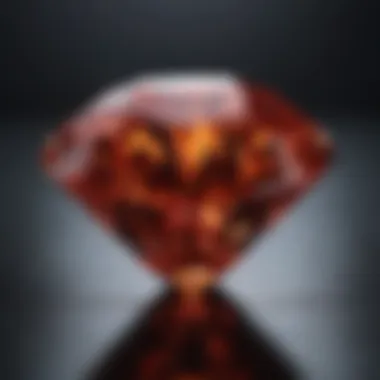
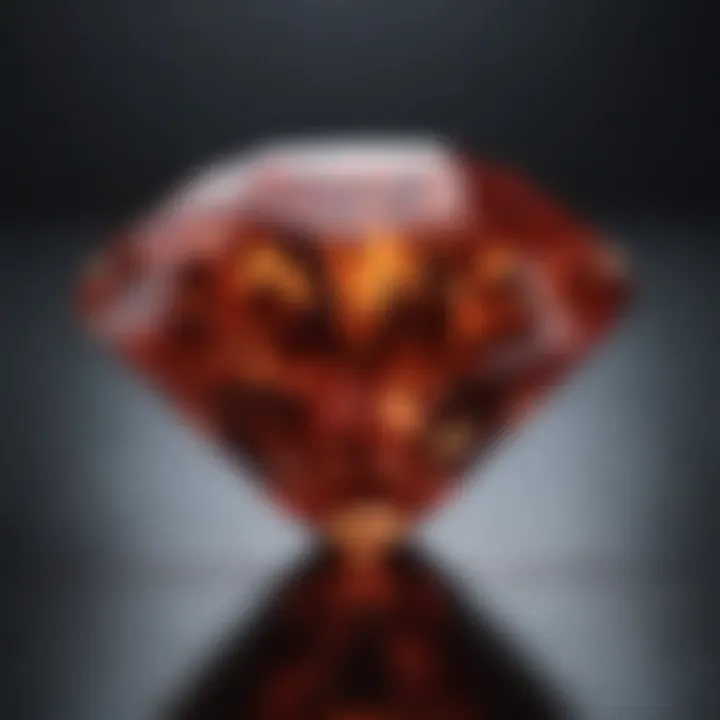
Intro
Natural red diamonds are among the rarest gemstones in the world. Their striking color and unique characteristics make them highly sought after by collectors and investors. Understanding the price dynamics of these diamonds requires a nuanced approach that takes into account various influencing factors. This section will provide an overview of key concepts related to red diamonds while setting the stage for a deeper exploration of their valuations.
Gemstone Overview
Definition and characteristics
Natural red diamonds are diamonds that exhibit a captivating red hue. Their color arises from the unique crystal structure of the stone, which affects how light interacts with it. Unlike synthetic diamonds, which are created in labs, natural red diamonds form under specific geological conditions over millions of years. This natural formation contributes to their value.
One notable characteristic is the depth and saturation of the color, which varies among individual diamonds. The grading of this color plays a crucial role in determining price; the more vivid the hue, the higher the value.
Classification of gemstones
Gemstones are typically classified based on several criteria, including origin, composition, and usage. Natural red diamonds fall under the category of precious gemstones, which also includes sapphire, emerald, and ruby. The rarity of red diamonds often eclipses that of other precious stones, making them unique in the marketplace.
- Natural vs. Synthetic: Natural diamonds occur naturally, while synthetic diamonds are man-made. The value of natural stones like red diamonds is generally more stable due to scarcity.
- Precious vs. Semi-Precious: Precious gemstones are rarer and more valuable, while semi-precious stones, while beautiful, are more common and thus less valuable.
It's essential for buyers to understand these classifications as they directly impact market perception and value.
Properties of Gemstones
Physical properties
The physical properties of natural red diamonds contribute significantly to their desirability. Key physical properties include hardness, brilliance, and durability. Diamonds are the hardest natural material, scoring a 10 on the Mohs scale, which ensures they withstand wear and tear better than many other gemstones. This durability makes them ideal for everyday wear, especially in engagement rings.
Their brilliance is also noteworthy; diamonds typically reflect light in a manner that enhances their visual appeal. In the case of red diamonds, the interplay of light and color can create mesmerizing effects for those who appreciate fine jewelry.
Chemical properties
The chemical composition of diamonds primarily consists of carbon. In red diamonds, the presence of other trace elements alters their color. This unique chemical composition not only contributes to their coloration but also affects other characteristics such as clarity and overall stability.
Understanding chemical properties can provide insights into the diamond's origin and can inform buyer decisions when assessing quality.
The rarity and unique properties of natural red diamonds make them a fascinating subject for collectors and investors, highlighting the importance of informed purchasing decisions in a complex market.
The Rarity of Natural Red Diamonds
Natural red diamonds hold a unique position in the gemstone market, primarily due to their extreme rarity. Understanding this rarity is essential for anyone looking to navigate the intricate pricing dynamics associated with these remarkable gems. The limited availability of natural red diamonds means that their value is significantly impacted by supply and demand factors, which makes them an interesting subject for collectors and investors alike.
Understanding Rarity in Gemstones
Rarity in gemstones is defined by several factors, including the availability of the stone, the quality of the gems produced, and the geographical location where they are sourced. Natural red diamonds are among the rarest stones globally, with estimates suggesting that there are possibly only a few dozen of these gems in existence. The unique color formation of red diamonds comes from a combination of their crystal structure and the presence of specific trace elements during their formation deep within the Earth.
The concept of rarity not only influences market demand but also drives sentiment and value perception. Many collectors seek out rare gems to diversify their portfolios or make unique statements, particularly when it comes to red diamonds. As a result, the rarity of red diamonds contributes to their allure, making them highly sought after in auctions and private sales.
Natural vs. Synthetic Red Diamonds
The introduction of synthetic red diamonds has added complexity to the market. Unlike natural diamonds, synthetic diamonds are created through artificial means, usually in laboratories, and can often be produced in larger quantities. While the appearance of synthetic red diamonds may be similar to their natural counterparts, the former lack the unique characteristics and history that come with natural stones.
Natural red diamonds carry with them stories of their origins, which synthetic versions cannot replicate. The diminishing availability of natural red diamonds amid growing demand has led to a premium price attached to authentic stones. Buyers must differentiate between natural and synthetic red diamonds to make informed purchasing decisions. Clear certification and documentation are critical in this regard, as they authenticate the origin of the diamond.
Distribution of Red Diamonds
Red diamonds are primarily sourced from a few locations worldwide, with Australia being the most notable due to its Argyle mine, which was the main supplier for decades until its closure in 2020. The geographical distribution of red diamonds adds another layer to their rarity, as the specific conditions required for their formation are not replicated easily in other locations. This limited geographic spread can influence price, as proximity to reputable sources can reduce transportation costs for dealers and collectors, further impacting the overall market dynamics.
"Natural red diamonds are a rare treasure, and their special qualities contribute not only to their price but also to their mystique and appeal."
In summary, understanding the rarity of natural red diamonds involves considering their unique formation, the distinction between natural and synthetic stones, and the limited geographical distribution of these gems. These facets collectively enhance the demand and perceived value, which are critical for pricing dynamics in the gemstone market.
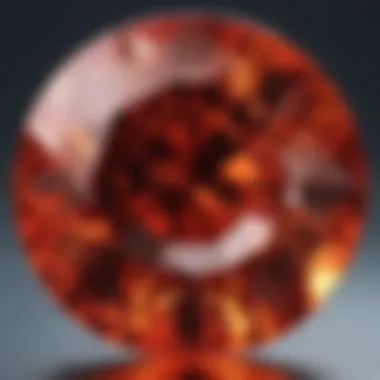

Historical Context of Red Diamonds
The historical context of natural red diamonds is crucial in understanding their price dynamics. The allure of these gems extends beyond their physical beauty, deeply entwined in cultural narratives and historical events. This history not only shapes the perceptions around their rarity but also influences their market value significantly.
Cultural Significance of Red Diamonds
Natural red diamonds have held a prominent place in various cultures throughout time. Their brilliant hue is often associated with strength, passion, and love, making them desirable tokens in many societies. In some traditions, red diamonds symbolize power and status, making them sought-after possessions among the elite. In many Eastern cultures, the color red has especially strong connotations, linking it to prosperity and good fortune.
Red diamonds are not just prized for their aesthetic appeal; they also carry narratives of historical importance. For instance, when used in royal jewelry, they reflect the wealth and influence of those who owned them. This cultural attachment enhances their allure, making them not just gemstones but treasures with rich stories linked to their bearers. Such significance can lead to increased demand, therefore influencing their market price.
Notable Red Diamonds in History
Throughout history, several famous red diamonds have captured public imagination and contributed to the reality of their prestige.
- The Moussaieff Red Diamond: Weighing in at 5.11 carats, this diamond is one of the most famous red diamonds known today. Its unique size and deep color have made it highly desirable, with estimates reaching over $8 million.
- The Red Emperor Diamond: Weighing approximately 3.02 carats, its exquisite depth of color has made it a subject of fascination among collectors and investors.
- The Darya-i-Nur: Though technically a pink diamond, its shades often transition into red, demonstrating how colors can carry various meanings throughout cultures and periods.
These high-profile stones are pivotal in driving the demand for red diamonds. Their existence often leads to spikes in interest, which can directly affect pricing trends in the market. Furthermore, the ownership histories of such diamonds can transform them into legendary artifacts, propelling their market value through time.
The historical narratives encompassing red diamonds serve as both a marketing tool and an investment asset, appealing to collectors' desires for unique and culturally potent pieces.
Understanding the historical context not only enriches the appreciation of natural red diamonds but also provides insight into their investment potential in today's market. Collectors and enthusiasts can discern not just the beauty of these gems but also the stories that add immense value.
Factors Influencing Natural Red Diamond Prices
The valuation of natural red diamonds is a nuanced process influenced by various interactive elements. Understanding these factors is crucial for collectors, investors, and enthusiasts alike. Price dynamics can often be complex, subject to shifts in market demand, rarity, and intrinsic qualities of the diamonds. This section will examine significant factors affecting the pricing of natural red diamonds, which can guide informed decisions for those looking in this exclusive market.
Color Intensity and Quality
The color intensity of a natural red diamond is perhaps the most significant determinant of its price. The grading of color intensity often follows a scale that ranges from faint to vivid, with vivid red diamonds commanding notably higher prices. Diamonds that display a pure, deep, and uninterrupted hue receive top value, elevating their demand within the gemstone market.
Factors contributing to this include:
- Hue: The specific shade of red plays a critical role. Those with a primary red, free from secondary tones, are the most desirable.
- Saturation: A highly saturated shade elevates the price. The impression of brightness and richness can significantly affect value.
- Uniformity: Consistent coloring throughout the stone leads to a more robust market valuation.
The relationship between color quality and price is particularly strong; it defines the diamond's overall appeal and receive offers that match its magnificence. Consequently, evaluating these attributes becomes key when determining potential investment returns.
Carat Weight and Sizing
Carat weight often plays a pivotal role in the pricing of natural red diamonds. Larger stones are typically rarer and, as a result, more valuable. The demand for substantial sizes can create competition among buyers, driving prices upward. However, price per carat does not rise linearly. Typically, the price escalates exponentially as carat weight increases, particularly when surpassing the one-carat threshold.
Key considerations in carat weight include:
- Market Demand: The prevailing demand for diamonds of certain sizes can significantly affect their price.
- Visual Impact: Larger diamonds tend to attract more attention, influencing their desirability in jewelry markets.
- Rarity: A unique, larger red diamond can be seen as an investment opportunity, driving its price even higher.
In this context, examining the weight alongside the quality offers more comprehensive insights into valuation, ultimately guiding pricing expectations.
Clarity and Cut
Clarity indicates the presence of internal or external flaws in a diamond. For natural red diamonds, high clarity grades can lead to substantial price increases. Buyers often pay premium prices for diamonds that exhibit minimal inclusions or blemishes. The cut of the diamond, while not directly impacting its rarity, plays a significant role in how light interacts with the stone, which affects its visual appeal and market value.
Relevant factors regarding clarity and cut include:
- Clarity Grade: Flawless or internally flawless diamonds are significantly more expensive compared to those with visible imperfections.
- Faceting Quality: A well-cut diamond can enhance brilliance and color performance. Proper cut enhances the attractiveness, coalescing demand and value.
- Shape: Certain cuts, like cushion or round, may influence market preferences and thus affect pricing trends.
In essence, the combined attributes of clarity and cut create a complex web impacting pricing. Collectors and investors must weigh these factors judiciously as they seek to navigate the intricate market of natural red diamonds.
"When assessing natural red diamonds, understanding the interplay of color, carat, clarity and cut can provide deeper insights into their price dynamics."
In summary, evaluating natural red diamonds requires awareness of these multifaceted influences. By understanding color intensity, carat weight, and clarity, stakeholders can make educated choices while participating in this vibrant market.
Market Trends in Natural Red Diamonds
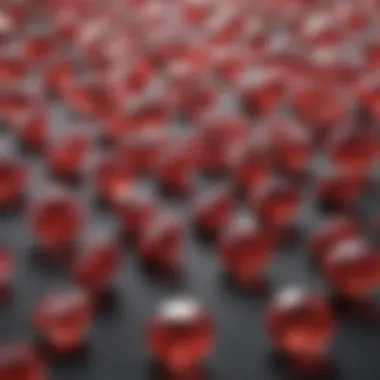

Market trends for natural red diamonds serve as a crucial focal point in understanding their price dynamics. These trends reveal insights into buyer behavior, market demands, and the overall value trajectory of these gemstones. As the market evolves, so does the perception of red diamonds, influenced by factors such as rarity, economic conditions, and cultural significance.
Price fluctuations highlight market health. Observing how these prices change over time can indicate shifts in supply and demand. This is significant for investors and collectors who want to capitalize on market movements. Additionally, trends help establish a baseline for assessing future investments. Recognizing historical patterns allows stakeholders to make informed decisions regarding purchasing and selling.
Understanding the unique market position of natural red diamonds is essential. Unlike their more common counterparts, red diamonds stand out due to their limited supply and exquisite color. This uniqueness can elevate their market value considerably. Consequently, industry participants must consider how external market trends, such as economic shifts or changes in consumer preferences, impact red diamond pricing.
Analyzing Price Trends Over Time
To analyze the price trends of natural red diamonds effectively, it is important to review historical pricing data. Over the past decades, these diamonds have shown a distinct upward trajectory in their valuation. The rarity and consistent demand have contributed to this trend.
- Historical average prices of natural red diamonds have increased annually in various instances, driven by limited availability and ongoing interest from collectors and investors.
- Market reports indicate that certain red diamonds have been sold at auction for millions of dollars, showcasing their high valuation.
The scarcity of natural red diamonds makes them a safe option in uncertain economic times. As financial markets fluctuate, the allure of tangible assets like gemstones remains. This dynamic leads to increased investments.
Current Market Valuation
Currently, the market valuation of natural red diamonds reflects a nuanced understanding of their worth. Recent valuations indicate a broad range, with some diamonds fetching record prices. Factors influencing the current valuation include color intensity, clarity, carat weight, and market demand.
"Due to their extreme rarity, red diamonds can command prices many times higher than conventional colored diamonds."
Current Key Valuation Metrics
- Color Depth: Darker and more intense red diamonds are valued higher.
- Carat Size: Larger stones typically have a higher price per carat.
- Clarity Ratings: Higher clarity ratings increase diamonds' desirability.
In summary, scrutinizing the current market valuation of these gemstones can offer insights into future trends. Investors should consider prevailing market conditions and buyer preferences when making decisions related to natural red diamonds.
Investment Potential of Natural Red Diamonds
The investment potential of natural red diamonds offers a fascinating intersection between financial strategy and the allure of rare gemstones. Given the extreme rarity and unique characteristics of these diamonds, they appeal to discerning collectors and investors. Their limited availability ensures that demand, coupled with a steady interest from investors, often leads to substantial long-term value appreciation. As the market for luxury goods continues to evolve, understanding the factors that contribute to the investment viability of natural red diamonds becomes crucial.
Long-Term Value Appreciation
Natural red diamonds have shown a remarkable trend towards long-term value appreciation. Factors such as rarity, historical significance, and market demand play a significant role in this trend. The rarity of natural red diamonds is perhaps their most compelling attribute, as fewer than 30 known to exist in the world. Their striking color and unique characteristics further enhance their status.
Investors often consider these diamonds not just as luxurious items, but as assets with potential for growth. For example, the prices of high-quality natural red diamonds have surged in recent years, illustrating their capability to appreciate in value more than traditional investments like stocks or bonds. This trend can be attributed to various factors, including:
- Limited supply in the market.
- Increasing interest from wealthy investors and collectors.
- Historical sales trends that show significant price increases over time.
As a result, investors looking for a hedge against market volatility may well find solace in the long-term investments represented by natural red diamonds.
Comparative Analysis with Other Gemstones
When comparing natural red diamonds to other gemstones, it is essential to assess both the unique attributes and market dynamics. While many gemstones can serve as investment options, few rival the appreciation potential of natural red diamonds. For instance, diamonds like blue, pink, or yellow have gained attention, but they often lack the historical allure or emotional connection that red diamonds carry.
Key considerations in this comparative analysis include:
- Price Per Carat: Red diamonds consistently feature higher price points than most other gemstones due to their rarity.
- Cultural Significance: Red diamonds often hold deep cultural and historical importance, making them desirable for collectors.
- Market Demand: As the market for colored diamonds diversifies, red diamonds remain a unique and coveted segment, often commanding a premium.
- Liquidity and Resale Opportunities: While many gemstones can experience fluctuations in value, the demand for red diamonds tends to stabilize prices, offering security in the resale market.
Investors should consider these elements seriously when evaluating their portfolio. Natural red diamonds present a viable investment opportunity, exceptional both for their aesthetic appeal and financial potential.
Challenges in Valuing Natural Red Diamonds
Valuing natural red diamonds poses unique challenges that intersect with market dynamics, authenticity concerns, and the broader context of gemstone investment. Understanding these challenges is critical for stakeholders such as investors, collectors, and jewelry designers. Issues like market volatility impact buyers’ confidence while authenticity concerns can compromise the overall integrity of transactions.
With the increasing popularity of red diamonds, the market experiences significant fluctuations. These fluctuations can often lead to confusion when determining fair market pricing. Additionally, the rarity of these gems makes standard appraisal methods less effective, and this complicates measurements of value.
In the world of gemstone investment, it is essential to acknowledge these challenges so that informed decisions can be made. Below are key factors that contribute to these complexities:
- Market Volatility: The gemstone industry is subject to rapid changes. External factors like economic conditions, geopolitical stability, and emerging market demands can drastically influence prices.
- Authenticity and Certification: The presence of synthetic counterparts raises concerns regarding the legitimacy of a diamond's value. A lack of reliable certification can lead to mistrust in the market.
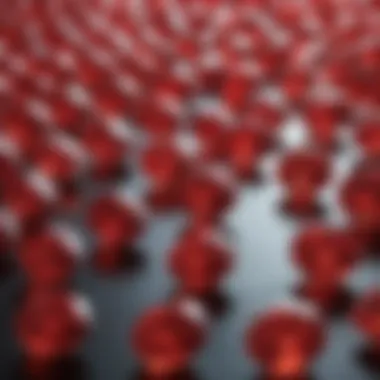

Market Volatility and Fluctuations
Market volatility is perhaps one of the most significant factors complicating the valuation of natural red diamonds. Prices can fluctuate dramatically based on various external conditions, including economic indicators, currency exchange rates, and shifting consumer preferences.
This sector is not immune to broader economic trends. For instance, during periods of economic downturn, luxury items like diamonds may see a decline in demand, causing prices to drop. Conversely, when the economy is strong, the appetite for high-value items may increase, leading to higher prices.
Additionally, events such as changes in import/export regulations or trade tariffs can also have far-reaching effects on the market. This cycle of volatility creates inherent risks for investors and collectors.
Authenticity and Certification Issues
The challenges of authenticity and proper certification present another critical hurdle in the valuation process. With the advent of advanced technology, the creation of synthetic diamonds has become more feasible, making it difficult to distinguish between natural and artificial gems.
The presence of synthetic diamonds in the market raises concerns about the authenticity of natural red diamonds. Misidentification can occur without the necessary gemological expertise, leading to significant financial implications.
For the market to maintain its credibility, trusted certification sources are essential. Organizations like the Gemological Institute of America (GIA) provide comprehensive grading services. However, not all diamonds come with reliable certifications, leaving buyers at a disadvantage when assessing true values.
Before investing or purchasing, consumers should prioritize obtaining a certificate from a reputable institute. This will help ensure their investment is protected against potential misrepresentation.
"A diamond's value is only as good as its authenticity. Without solid certificates, the investment landscape becomes murky."
In summary, the valuation of natural red diamonds is fraught with challenges that require careful navigation. An understanding of market volatility and the importance of authenticity forms the bedrock of making informed decisions in this complex sector.
Ethics and Sourcing of Red Diamonds
The topic of ethics and sourcing of red diamonds is critical in understanding their overall market dynamics. Natural red diamonds, due to their extreme rarity and high value, can attract unethical practices such as exploitation and smuggling. Therefore, it is essential to investigate the processes behind their mining and trade.
Responsible sourcing is not just a moral obligation; it reflects on the overall market image. When consumers become aware of the origins of their gemstones, they place greater value on ethically sourced diamonds. As demand increases for conflict-free products, this creates a ripple effect in the market, promoting higher standards for mining practices.
Responsible Mining Practices
Responsible mining practices ensure that natural red diamonds are harvested in ways that respect both human rights and the environment. Key elements include:
- Transparency in the supply chain: Consumers should have access to information about the origin of the diamonds. This transparency helps prevent exploitation of labor and promotes sustainable practices.
- Environmental considerations: Proper techniques should be employed to minimize ecological impact during mining.
- Support for local communities: Ethical mining should contribute positively to the communities affected by mining operations, providing jobs and economic benefits.
By implementing responsible mining practices, the industry can work towards sustainability while maintaining the high value of these rare gemstones.
Impact of Conflict Diamonds
The term "conflict diamonds" refers to gemstones mined in war zones and sold to finance armed conflict. While red diamonds are not often associated specifically with conflict diamonds, the issue is still relevant. Consumers increasingly want to avoid contributing to any form of exploitation or violence linked to diamond sourcing. This leads to greater scrutiny of the entire diamond supply chain.
Consequently, there is a growing push for certification standards in the diamond industry. The Kimberley Process aims to prevent the trade of conflict diamonds by ensuring that diamonds are sourced from conflict-free areas. While this framework has been beneficial, it is not flawless. Some loopholes still exist, allowing conflict diamonds to enter the market.
"Raising awareness about the origins of gemstones is a crucial step towards ensuring ethical standards in the industry."
The impact of these elements on consumer behavior can significantly influence prices in the market. An increasing number of buyers favor diamonds sourced responsibly, which can drive up values for ethical gemstones while reducing demand for non-certified ones.
In summary, the ethics and sourcing of red diamonds are not just theoretical discussions. They have tangible effects on market dynamics and consumer decision-making. Understanding these factors is essential for collectors and investors alike.
Finale: The Future of Natural Red Diamond Prices
Understanding the future of natural red diamond prices is critical for several reasons. The market for these gemstones is unique, characterized by factors that significantly influence their valuation. As scarcity increases, the demand among gemstone collectors and investors continues to rise. Through a careful analysis of market trends, we can gain insight into potential price movements. This section provides an overview of predictions and final thoughts regarding investment in natural red diamonds.
Predictions for Price Trends
When examining predictions for future price trends, it is essential to consider various influencing factors. First, the limited availability of natural red diamonds will continue to exacerbate their rarity. This scarcity drives up demand, leading to higher prices. Historical trends show that as these diamonds become even less available, buyers are likely to be willing to pay a premium.
Another significant factor is the growing interest in sustainable and ethically sourced gemstones. Investors are increasingly recognizing the importance of responsible procurement practices in the gemstone market. Consequently, diamonds that can demonstrate ethical sourcing are likely to fetch higher prices, reflecting the preferences of conscientious consumers.
In addition, the economic climate will play a substantial role in price dynamics. Investment in luxury goods, including natural red diamonds, often fluctuates with economic stability. During times of economic prosperity, the demand for high-value gems tends to rise. Conversely, in periods of economic downturn, luxury items may see a dip in demand. Keeping an eye on the global economy will provide valuable clues about future pricing trends for red diamonds.
"As the market evolves, continuous research and understanding of consumer preferences will be paramount to predict price movements."
Final Thoughts on Investment
Investing in natural red diamonds holds potential, but it requires careful consideration. As these diamonds are among the rarest gemstones in existence, their long-term value appreciation seems promising. However, investors must stay informed about the market, including trends and valuations. It is wise for potential buyers to consider various factors, such as the diamond's color intensity, cut, and clarity when evaluating investment opportunities.
Moreover, aligning investments with personal values, such as ethical sourcing and sustainability, can not only enhance personal satisfaction but also increase the diamond's desirability in the market. Engaging with certified dealers and obtaining proper documentation is vital in minimizing risks concerning authenticity and value.



